Sauroposeidon proteles Reconstructed
Brachiosaurs were big. Maybe too big for camouflage.
When I look at illustrations of dinosaurs, even very technically good ones, I’m often left with the uneasy feeling that it just doesn’t ‘feel’ like a real animal. Its as if only two simple layers have been added to the still-recognizable skeleton – while living vertebrates often look nothing like their skeletons. This has compelled me to try and push my dino reconstructions beyond just draping skin and major muscle groups over the skeleton. I want to see them come alive, living and breathing beings with muscle, cartilage, circulatory systems, fat, skin, feather, hair, horn, complex eyes, and, as in this case, elaborate display structures.
This illustration was inspired by the work of paleobiologists Matt Wedel, Mike Taylor and Darren Naish who write two of the best paleo blogs on the web, Sauropod Vertebrae Picture of the Week (SV-POW!) and Tetrapod Zoology (Tet Zoo). They are also badass paleobiologists who not only dig up fossils and study dinosaurs, but also spy on them, dissect them, and mail order their severed heads to skeletonize them. I have also heard rumors that they are working on a time-traveling three-part combining robot machine and have lazer gunz (this, however is not officially confirmed).
Their blogs contain a wealth of information and discourse invaluable to any artist trying to reconstruct dinosaurs, especially sauropods. On Darren Naish’s blog, Tet Zoo, I found an informative and easy-to-read post describing how to best reconstruct the manus (hands) of sauropods, which I referenced frequently while reconstructing the stompers on my Sauroposeidon.
The elaborate display structures were inspired by various posts on SV-POW from which I learned that sauropods have highly pneumatic skeletons. This means there are air sacs and hollows throughout their skeletal systems much like a bird’s. These skeletal features suggest that Sauropods also had complex respiratory systems, also like those of modern birds. When I learned that, I got very excited, because birds don’t just use their wacky respiratory systems for breathing, they also use them for inflating crazy display structures. With that in mind I did this rough sketch:
Matt Wedel has done a bunch of work studying pneumaticity, especially with regards to sauropods, and he was nice enough to take a look at my rough sketch and give me some feedback:
“I think it rocks. But not nearly enough. Look up some pictures of prairie chickens, hooded seals, singing frogs, and everything else with inflatable display sacs. They don’t look like they just swallowed a stick of Mentos–they look like freeze-frames from half a millisecond after the the detonation of that bomb they swallowed. Real display sacs are so big and so colorful that no other animal could possibly mistake them for anything else. Therefore if you want to draw speculative display sacs they must be so big and colorful that none of the people who see the piece could possibly mistake them for anything else.”
And he’s totally right. Real animals are ridiculous.
Our conservative reconstructions simply don’t do extinct monsters justice. Or, as Matt put it in the same email:
“If you go bold, you won’t be right; whatever you dream up is not going to the same as whatever outlandish structure the animal actually had. On the other hand, if you don’t go bold, you’ll still be wrong, and now you’ll be boring, too.”
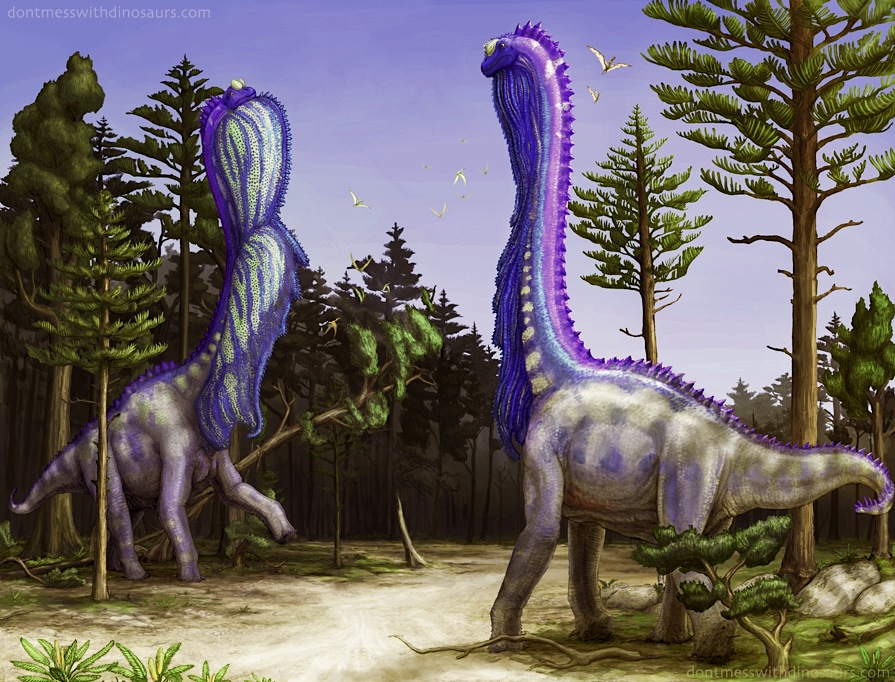
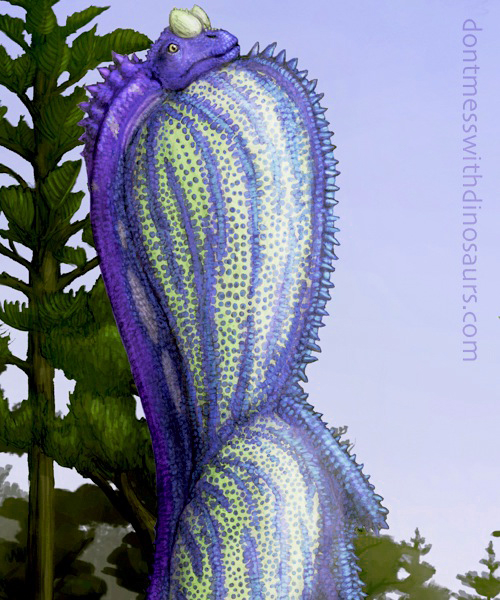



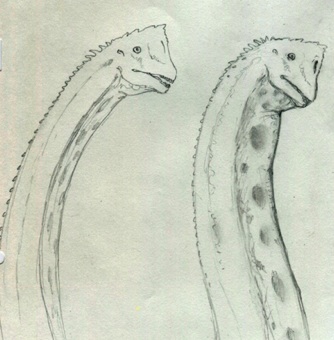
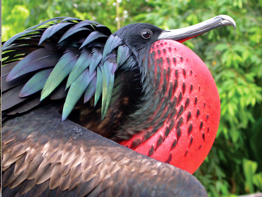
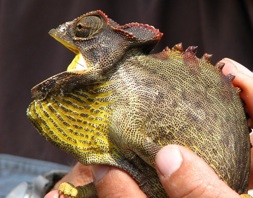
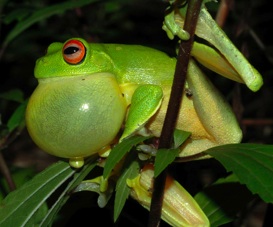
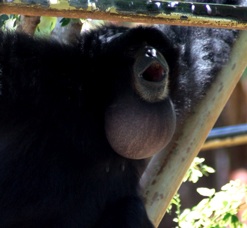

Matt Wedel on 08 Dec 2010 at 4:54 pm #
Rock! I love how the illustration turned out. Nice work on the post, too. Oh, and I’ll have one of those little clay brachiosaurs, thanks. So that’s a trifecta of awesomeness for you–congratulations. Stay tuned imminent for SV-POW!ization!
Glendon Mellow on 08 Dec 2010 at 4:57 pm #
This post is so inspirational. Your work is fantastic.
Albertonykus on 09 Dec 2010 at 6:01 am #
Wow! Good job!
Historian on 09 Dec 2010 at 8:28 am #
!!!!Trifecta of of awesomness + trifecta of comments! = double trifecta!!!!!!?
Matt on 09 Dec 2010 at 11:09 am #
I lack a sufficient number of thumbs to put in the up position.
Your reconstruction falls into the so different it can’t be wrong category! Inspired and inspiring stuff!
Graham King on 11 Dec 2010 at 4:50 am #
Brilliant sauropod! with a flagpole that size, why not hang banners and balloon-sails on it! And your excavating (suit? robot?) is a must-have for palaeontologists!
(of which I am not one, but if I were, that’s what I’d want to inhabit and rove badlands in.)
Pimp my ‘pod 2: haids « Sauropod Vertebra Picture of the Week on 13 Dec 2010 at 5:25 am #
[…] on a related topic (with kind permission–thanks, Brian!). Back when he was first planning his awesome Sauroposeidon life restoration, Brian sent these head […]
Jacinto on 28 Jan 2011 at 12:15 am #
ES genia el sauroposeidon su papada es muy rara y de colores extrabagantes
C. M. Kosemen on 06 Feb 2011 at 6:30 pm #
Great painting and great concept – I’d had a go at this type of speculation a year ago, but it was on a hypothetical “intelligent sauropodoid” http://svpow.wordpress.com/2010/06/17/i-for-one-welcome-our-new-sauropod-overlords/
Hope you enjoy…
Historian on 07 Feb 2011 at 10:30 pm #
Oh man! I know! I had been talking with Matt about inflatable display structures and pneumaticity quite a while ago (about 2 and half years now), but I never got around to finishing my illustration until recently. When I saw your intelligent Sauropoid and said “Blast!! I’ve been beaten to it!”
I figured I had to get my take on the concept out eventually so I did. Fortunately we both took totally different approaches, visually and conceptually.
Anyway, I hope you don’t feel plagiarized or anything like that – I’m all about giving credit where credit is due, but I honestly had my similar idea independently – long before I saw your work on SV-POW! You can confirm with Matt – some of my sketches he posted in his discussion about my Sauroposeidon reconstruction were actually ones I sent to him several years prior.
Your intelligent sauropoid is a great design. Really good creature concept. I really like what you did with the ridge-like scale structures – something I would’ve never thought of doing, but definitely looks cool and plausible. Keep up the good work!
Dr-XIII on 19 Jul 2011 at 1:19 am #
I’d hate to be a critic, but those Brachiosaurs look more like aliens than dinosaurs.
Historian on 21 Jul 2011 at 5:00 pm #
you know what aliens look like???
Sideshow Collectibles Apatosaurus maquette, Part 5: posture « Sauropod Vertebra Picture of the Week on 30 Nov 2011 at 2:01 am #
[…] example, I think it would be a mistake to look at Brian Engh’s inflatable Sauroposeidon duo and infer that he accepts a raised alert neck posture for sauropods. He might or might […]
QuestioScientia.com » Sexual selection in the fossil record on 08 Sep 2012 at 7:28 am #
[…] To see the original, uncropped version of the ridiculous brachiosaur reconstruction shown above, go here. For previous articles on some of the issues mentioned here, […]
The Diamantinasaurus in the cave: definitely unfamiliar this time | Sauropod Vertebra Picture of the Week #AcademicSpring on 08 Mar 2013 at 7:55 pm #
[…] are certainly interesting but not particularly outlandish (Brian’s already done outlandish). And it’s pretty darned hard to argue that sauropods never went into caves, although I […]
Pimp my ‘pod | Sauropod Vertebra Picture of the Week on 16 Sep 2013 at 6:34 am #
[…] view, just to give you a taste; for the high resolution awesomeness, check out Brian’s post here. While you’re over there, check out his line of mini-brachiosaur sculptures–the perfect […]
A bit of Dreadnoughtus for Stanford University Magazine | The Optimistic Painting Blog on 22 Nov 2014 at 2:23 am #
[…] The large wattle on Dreadnoughtus is very much stolen from the brilliant Brian Enge’s concept of large display features on sauropods. […]